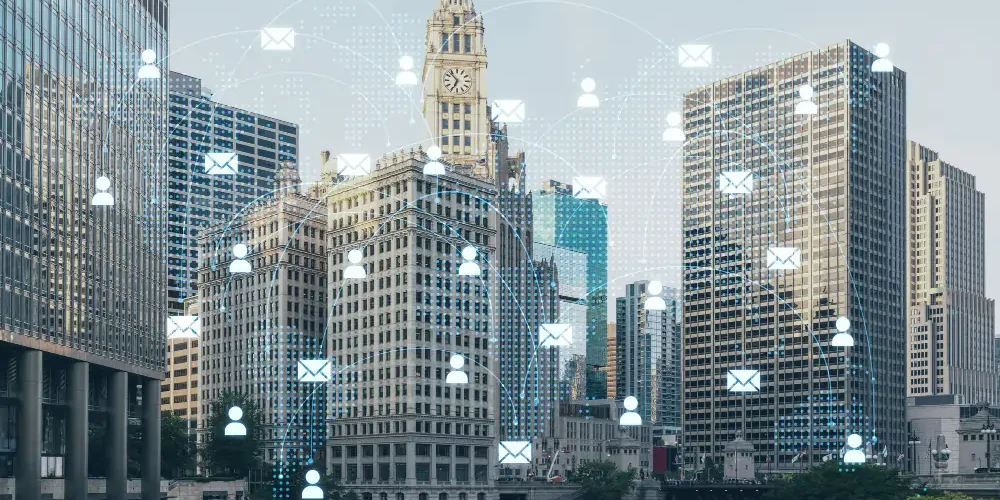As New York City rolls out Local Law 97 (LL97), part of the larger Climate Mobilization Act, building owners and managers are turning to advanced technologies for solutions. AI and building automation emerge as pivotal tools in this endeavor, offering innovative ways to meet stringent emissions targets and avoid hefty fines. This blog delves into how these technologies are shaping the future of urban building management and compliance under LL97.
Understanding LL97 and Its Implications
Local Law 97 imposes strict emissions limits on buildings larger than 25,000 square feet, which encompass a significant portion of NYC’s built environment. The law is set to take effect in phases, starting in 2024, with the goal of reducing citywide emissions by 40% by 2030 and by 80% by 2050. Buildings that exceed these limits will face substantial penalties, underscoring the urgency for effective compliance strategies.
The Role of AI in Building Management
AI is revolutionizing building management systems (BMS) by enabling more efficient use of energy and resources. Here’s how AI contributes to LL97 compliance:
1. Predictive Analytics for Energy Management: AI can analyze historical energy usage data along with real-time inputs from various building systems to predict future energy needs and adjust operations accordingly. This predictive capability ensures buildings operate at peak efficiency, minimizing waste and reducing emissions.
2. Fault Detection and Diagnostics: AI-driven systems continuously monitor the health of a building’s mechanical and electrical equipment. By identifying issues that may lead to inefficiencies or increased energy use, such as HVAC faults or lighting issues, AI helps maintain optimal performance levels, directly contributing to emission reductions.
3. Automation of Heating, Ventilation, and Air Conditioning (HVAC) Systems: AI algorithms can automatically adjust temperature and air flow based on weather forecasts, occupancy patterns, and other environmental variables. This not only enhances comfort but also significantly cuts down energy consumption and associated emissions.
Also Read: Upgrading Your Lighting to Comply with NYC Local Laws 88 and 97
Building Automation’s Impact on Compliance
Building automation systems (BAS) integrate various components of a building’s operations into a cohesive, responsive network, driven by both AI and manual controls. Here’s how automation supports LL97 compliance:
Integrated Control Systems: Modern BAS can control lighting, heating, cooling, and ventilation through a single interface. By optimizing these systems to work together based on actual building use and external conditions, BAS reduce unnecessary energy expenditure.
Occupancy Sensors and Timers: Automation technologies that adjust lighting and climate controls based on real-time occupancy help eliminate energy waste. For example, rooms not in use can be set to lower heating or cooling settings, directly impacting the building’s overall energy profile.
Remote Monitoring and Management: Automation allows for remote monitoring and management of building systems, making it easier to ensure that energy use is aligned with compliance goals at all times, even during non-working hours or in less frequently used spaces.
Also Read: Local Law 97 Is Redefining the Future of Built Environment in New York City
Challenges and Considerations
While AI and building automation present promising solutions, there are challenges to consider:
– Cost: Initial installation and ongoing maintenance of advanced AI and automation systems can be significant. However, these costs must be weighed against potential penalties for non-compliance with LL97.
– Complexity and Skill Gaps: Implementing sophisticated AI solutions requires technical expertise. Building owners might face challenges in hiring skilled professionals who can manage these advanced systems.
– Data Privacy and Security: As buildings become smarter, they also become more connected. This raises concerns about data privacy and cybersecurity, which must be addressed through robust security protocols.
Conclusion
AI and building automation are not just tools for compliance; they are transforming how buildings are managed, making them more sustainable and efficient. As NYC’s LL97 puts a spotlight on emissions reductions, the deployment of these technologies will be crucial. For building owners in New York City and beyond, investing in AI and automation could be the key to future-proofing properties against increasingly stringent environmental regulations while paving the way for more sustainable urban living.







